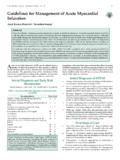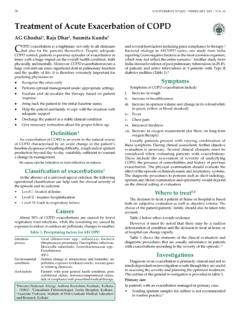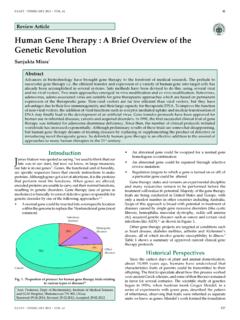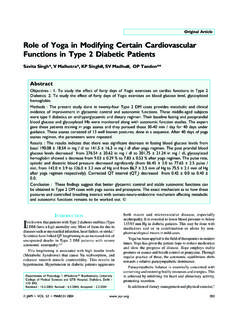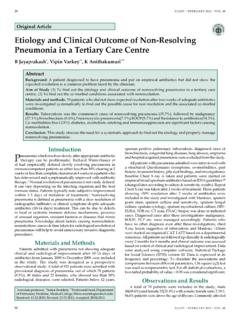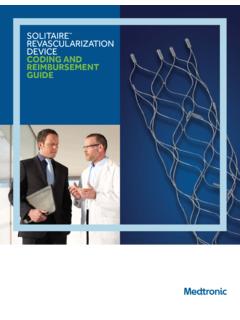Transcription of Approach to STEMI and NSTEMI
1 SUPPLEMENT TO JAPI dEcEMbEr 2011 V O L . 59 19 IntroductionAcute coronary syndrome (AcS) represents the clinically manifest acute myocardial ischemia. acute ischemia is usually, but not always, caused by atherosclerotic plaque rupture, fissuring, erosion, or a combination with superimposed intracoronary thrombosis, and is associated with an increased risk of cardiac death and myonecrosis. AcS comprises non ST elevation ACS (NSTE-ACS), Unstable angina (UA) and ST elevation MI( STEMI ). The crEATE rEGISTrY1 data revealed that NSTE ACS patients take a long time to reach hospital in India, and the frequency of NSTEMI exceeds that of STEMI in contrast to the West. It is important to note that mortality of STEMI and NSTEMI are comparable after six A large number of guidelines are available from different societies.
2 In this article a systematic Approach to AcS (UA, NSTEMI ANd STEMI ), will be NSTEMIC linical presentationAcute chest pain is one of the most common reasons for presentation to the emergency, however only 15-20% patients with chest pain actually have AcS after In view of missed diagnosis (2% patients approximately)3 and atypical presentation of AcS patients,4 a proper Approach is very important. Approach to diagnosis of patients with acute coronary syndrome (ACS) is indicated in Figure following clinical presentations are usually included in unstable angina,6 Prolonged (> 20 min) anginal pain at rest. New onset (de novo) severe angina (class III of the classification of Canadian Cardiovascular Society (CCS).7 Recent destabilization of previously stable angina with at least CCS III angina characteristics (crescendo angina) or Post MI typical clinical presentation of NSTE AcS is retro sternal pressure or heaviness ( angina ) radiating to the left arm, neck or jaw which may be intermittent (usually lasting several minutes) or persistent.)
3 There are several atypical symptoms and these include epigastric pain, recent onset indigestion, stabbing chest pain, chest pain with pleuritic symptoms, or increasing dyspnea. Atypical complaints are often observed in younger and older patients, in women, and in patients with diabetes. Detailed history and physical examination : History of presenting symptoms and standard risk factors (Age, DM, HTN, smoking, family history, anginal episodes, dyspnoea, aspirin intake, past history of similar episodes, cAd, dyslipidemia etc) has to be taken and clinical examination is frequently normal. The presence of tachycardia, heart failure or haemodynamic instability must prompt the physician to expedite the diagnosis and treatment of patients.
4 It is important to identify clinical circumstances that may precipitate or exacerbate NSTE- AcS, such as anemia, infection, fever and metabolic or thyroid disorders. An important goal of physical examination is to exclude non-cardiac causes of chest pain and non-ischemic cardiac disorders ( pulmonary embolism, aortic dissection, pericarditis, valvular heart disease) or extra cardiac to STEMI and NSTEMILal C Daga1, Upendra Kaul2, Aijaz Mansoor31 Fellow DNB Cardiology, 2 Executive director and dean, 3 Junior consultant, Fortis Escorts Heart Institute and research center, Okhla road, New delhi- 100028 AbstractAcute coronary syndrome (AcS) refers to any constellation of clinical symptoms that are compatible with acute myocardial ischemia.
5 AcS is divided into ST- elevated myocardial infarction ( STEMI ), non-ST elevated myocardial infarction ( NSTEMI ), and unstable angina (UA). STEMI results from complete and prolonged occlusion of an epicardial coronary blood vessel and is defined based on EcG criteria.. NSTEMI usually results from severe coronary artery narrowing, transient occlusion, or microembolization of thrombus and/or atheromatous material. NSTEMI is defined by an elevation of cardiac biomarkers in the absence of ST elevation. The syndrome is termed UA in the absence of elevated cardiac enzymes. History, physical examination, ECG, biochemical markers, ECHO all remain important tools to make an appropriate diagnosis The management of ACS should focus on rapid diagnosis, risk stratification, and institution of therapies that restore coronary blood flow and reduce myocardial 1 : Approach to diagnosis of patients with acute coronary syndrome (ACS)Patients with acute Chest Pain15-20% Patients with ACSNo ST elevationECGC ardiac biomarkers(Troponin, CPK-MB Normal)Unstable angina (UA)Non ST elevation myocardialinfarction ( NSTEMI )ST elevation myocardialinfarction ( STEMI )Non Q wave MIQ wave MICardiac biomarkers (Troponin, CPK-MB Raised)ST elevation20 SUPPLEMENT TO JAPI dEcEMbEr 2011 VOL.
6 59 Table 1 : The TIMI risk score for NSTE-ACSC haracteristics PointsHistorical Age 65 1 3 risk factors for CAD 1(dM,HTN, SMOKING,HIGH cHOLESTErOL,FAMILY HISTOrY) Known CAD (Stenosis 50 %) 1 Aspirin use in past 7 days 1 Presentation 2 anginal events in < 24 hrs 1 ST segment deviation mm 1 cardiac markers 1 risk Score = Total Points (0-7)Fig. 2 : Approach to Management of STEMI PATIENT WITH NSTEMI ASPIRIN 162-325MG ENTERIC COATED F/B 75-150MG 300 MG F/B 75 MG DAILY.(PCI-600 MG LD)LMWH ENOXAPARIN 1MG/KG BD SCBETA BLOCKER/CCBSL/IV NTG STATIN 80 MG LOW RISK(TIMI <3) INTERMEDIATE RISK (TIMI3-4) HIGH RISK (TIMI5-7) EARLY NONINVASIVE STRESS TESTING 1. OBSERVE FOR 8-12 HRS FOR RECURRENT CHEST PAIN , ARRHYTHMIAS. 2. ECG/CARDIAC ENZYMES DONE 3.
7 NONINVASIVE STRESS TESTS AND CT ANGIO NEGATIVE POSITIVE NORMAL 1 DISCHARGE PATIENT ON MEDICAL MANAGEMENT AFTER 3 DAYS/SOS THE PATIENT CAG +/- PCI WITH GPIIB/IIIA OR ABNORMAL Electrocardiogram (ECG)In NSTE ACS, ECG may show ST segment deviation, T wave changes or may remain normal. In several studies, around 5% patients with normal ECG who were discharged from the emergency department were ultimately found to have acute MI or ST segment shifts and T wave changes are the ECG indicators of unstable CAD. The number of leads showing ST depression and the magnitude of ST depression are indicative of the extent and severity of ischemia and correlate with the ST depression of > 2 mm carries an increased mortality risk. Inverted T waves, especially if marked (greater than or equal to 2mm ( mv) also indicate UA/ NSTEMI .)
8 Q waves suggesting prior MI indicate a high likelihood of IHD. Biochemical MarkersCardiac troponin (CTn) is the biomarker of choice because it is the most sensitive and specific marker of myocardial injury/ necrosis available. Troponin levels usually increase after 3-4 hours. If the first blood sample for CTn is not elevated, a second sample should be obtained after 6-9 h, and sometimes a third sample after 12 to 24 hours is required. Troponin level may remain elevated up to 2 weeks. Elevated CTn values signal a higher acute risk and an adverse long term creatine Kinase MB is less sensitive and specific for the diagnosis of NSTE ACS. However, it remains useful for the diagnosis of early infarct extension (reinfarction) and peri-procedural MI because of its short half life.
9 NT-Pro BNP is helpful in assessing left ventricular failure and Doppler examination should be done after hospitalization to assess the global left ventricular function and any regional wall motion abnormality. Echocardiography also helps in excluding other causes of chest Stratification at presentationNSTE ACS includes a heterogeneous group of patients with a highly variable prognosis. The risk stratification (Table 1) is necessary for prognosis assessment and treatment. A simple TIMI risk score11 has been validated and can be used. A TIMI score <3 usually indicates a low risk and a TIMI score = 3-4 indicates intermediate risk, where as score of 5-7 is high general, patients having multiple coronary risk factors, advanced age, rest angina, clinical left ventricular (LV) dysfunction, prior history of percutaneous coronary intervention (PCI) or coronary artery bypass graft surgery (CABGS) or patients with dynamic ST-T changes and elevation of troponin or CK-MB indicates myocyte necrosis and a high risk.
10 There are other risk models based on PUrSUIT trial12 and GrAcE : Approach to management of NSTEMI is shown in Figure 2. Patients who are awaiting hospitalization are advised to chew non-enteric coated aspirin (162 to 325 mg) and use sublingual nitrate for pain to Management of NSTEMIP atients with definite or probable NSTE-AcS who are stable should be admitted to an inpatient unit for bed rest with continuous rhythm monitoring and careful observation for recurrent ischemia. High risk patients, including those with continuing discomfort and/ or haemodynamic instability, should be hospitalized in a coronary care unit (CCU) and observed for at least 24-48 hours. Fibrinolytic (thrombolytic) therapy using streptokinase, urokinase, tenecteplase or any other agent should not be used in patients with UA and NSTEMI .
